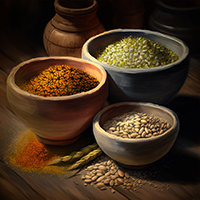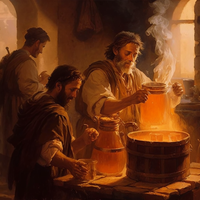Beer Before Hops: An Ancient Roman Recipe!
Posted by Matteo Lahm on 27th Feb 2023
In an earlier post, you got a brief history of how hops came to be an essential component in beer making. But it is known that beer making goes much farther back than 8th century Germany, so what was used in their place?
Prior to the 8th century, ancient beer makers used a variety of herbs and spices to flavor and preserve their beer. These included ingredients such as bog myrtle, yarrow, juniper, and heather. These herbs were used in beer recipes throughout Europe, and were also used to make mead and other alcoholic beverages. Examples of where these herbs were used include in the Nordic countries, where bog myrtle was used to flavor beer, and in the British Isles, where heather was used to make mead. Middle Eastern, North African, and Asian beer makers used a variety of spices and herbs to flavor and preserve their beer. These included ingredients such as coriander, cardamom, ginger, and anise. These spices were used in beer recipes throughout the Middle East, North Africa, and Asia. Examples of where these spices were used include in India, where cardamom was used to flavor beer, and in Egypt, where anise was used to make mead.

The ingredients that would have provided the bitter flavors in the absence of hops are coriander, cumin, fennel, anise, cardamom, cinnamon, ginger, and nutmeg. These spices were used in ancient beer recipes to provide bitterness and flavor, but they were eventually replaced by hops due to their advantages. Hops are easier to store and transport than the spices, and they provide a more consistent bitterness and flavor. Additionally, hops are a natural preservative, which helps to extend the shelf life of the beer.
The flavors imparted by cumin, fennel, anise, cardamom, cinnamon, ginger, and nutmeg are all distinct. Coriander and cumin would have added a slightly spicy and earthy flavor, while fennel, anise, cardamom, cinnamon, ginger, and nutmeg would have added a sweet and aromatic flavor. The dates and honey add a sweet and fruity flavor to the beers. Ancient Egyptian beers would have had a slightly spicy and earthy flavor with a sweet and fruity finish. The ancient Roman beers would have had a sweet and aromatic flavor with a hint of spice and a sweet and fruity finish.
Ancient Egyptian beer recipes were typically made with barley, emmer wheat, and dates. Ancient Roman beer recipes were typically made with barley, oats, and honey. Both cultures also used herbs and spices to flavor their beers. Both ancient Egyptian and Roman beers typically fermented for several days before they were ready to drink.
While the ingredients to these ancient beers are known, the yeast process is not. It is speculated that they used dough from breadmaking. The vessels used to store and serve the beer would have been made of clay or pottery. It is not known how they were cleaned and sanitized. They obviously did not have Star San or Easy Clean but it is likely that they used boiled water and natural cleaning agents such as lemon juice. Lucky for you, it is 2023 and you have modern sanitizers at your disposal.
There is a record in existence from the 4th century from Zosimus, an alchemist, who lived in Panopolis, Egypt, when it was part of the Roman empire. Zosimus' beer recipe was a simple one. He used barley and water to create a basic beer. He then added a variety of herbs and spices to the mix, including coriander, anise, and cumin. The beer was then boiled and left to ferment for several days. After fermentation, the beer was strained and bottled. The result was a light, refreshing beer with a hint of spice. Here is an adaptation of the recipe.
Five-gallon Batch:
Barley: 20 lbs
Water: 5 gallons
Fresh Coriander: ½ cup
Anise seeds: ½ cup
Cumin seeds: ½ cup
Steps:
1. Begin by combining the barley and water in a large pot at 150-155 degrees F for pre-mash. Allow to soak for 1 hour.
2. Add the coriander, anise, and cumin.
3. Raise temperature 180-185 degrees F for 30 minutes and then reduce the heat and simmer for several hours.
4. Sparge with hot water 180-185 degrees F for about 30 minutes.
5. The cold break process was not invented until the 19th century. The ancients just allowed it to cool. You could add this step as a modern adaptation. Barley wort should be chilled to below 60F.
6. Add yeast to the mixture and ferment. Good yeast choices would include Safale US-05 and White Labs WLP001 California Ale.
7. After fermentation is complete, transfer to a carboy and top up. Leave for several weeks.
8. Bottle. The ancients did not have priming sugar either. You could also try this as well.
9. Allow the beer to age for several weeks before serving.
The ABV of this beer was low so if you wanted more alcohol, you can add honey until you reach your desired specific gravity. Make sure it is consistent with the type of yeast you use. You could also experiment with other ingredients used at the time if you want to get creative.
So, there you have it! The hops used today are a recent innovation in the long history of beer making. If you want to have a little fun and take a stroll down history lane, try making this ancient Roman beer. You might be in for a wonderful and unexpected surprise. Good luck!

